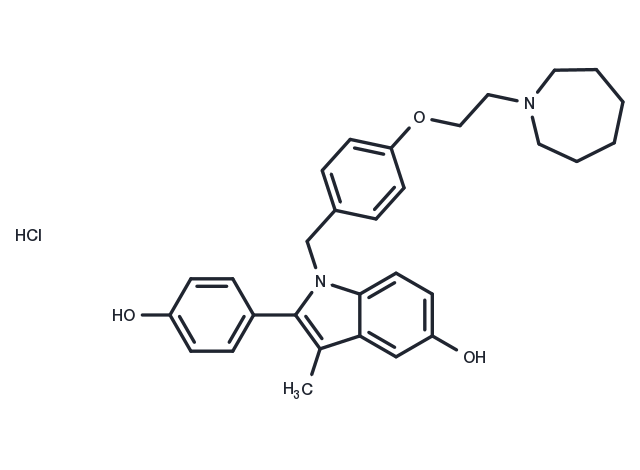Powder: -20°C for 3 years | In solvent: -80°C for 1 year


Bazedoxifene hydrochloride (TSE-424) is a novel, non-steroidal, indole-based estrogen receptor modulator (SERM) binding to both ERα and ERβ with IC50 of 23 nM and 89 nM, respectively.

| Pack Size | Availability | Price/USD | Quantity |
|---|---|---|---|
| 2 mg | Inquiry | $ 78.00 | |
| 5 mg | Inquiry | $ 140.00 | |
| 10 mg | Inquiry | $ 252.00 | |
| 25 mg | Inquiry | $ 394.00 | |
| 50 mg | Inquiry | $ 709.00 | |
| 1 mL * 10 mM (in DMSO) | Inquiry | $ 252.00 |
| Description | Bazedoxifene hydrochloride (TSE-424) is a novel, non-steroidal, indole-based estrogen receptor modulator (SERM) binding to both ERα and ERβ with IC50 of 23 nM and 89 nM, respectively. |
| Targets&IC50 | ERβ:89 nM, ERα:23 nM |
| In vitro | Bazedoxifene is a third generation selective estrogen receptor modulator (SERM). Bazedoxifene does not stimulate ERα mediated transcriptional activity and acts as an antagonist to estradiol in cultured breast cancer (bMCF-7) cells. Similar results are seen in other cell lines including CHO (ovarian), HepG2 (hepatic) or GTI-7 (neuronal) with bazedoxifene having no ERα agonist activity and acting as an antagonist to estradiol action.[2] Bazedoxifene does not stimulate proliferation of MCF-7 cells but did inhibit 17β-estradiol-induced proliferation with IC50 of 0.19 nM. [3] |
| In vivo | In an immature rat model, bazedoxifene increases uterine wet weight 35% at a dose of 0.5 mg/kg compared to an 85% increase with raloxifene at the same dose and a 300% increase in uterine weight with ethinyl estradiol at a dose of 10 μg/kg. Ovarectomized rats treated with 0.3 mg/d bazedoxifene displayed maintenance of bone mass and bone strength similar to effects seen with 2 μg/d ethinyl estradiol, 3 mg/d raloxifene, or sham operated animals. [2] |
| Kinase Assay | Ligand binding competition experiments: Test compounds are initially solubilized in DMSO and the final concentration of DMSO in the binding assay is ≤ 1%. Eight dilutions of each test compound are used as an unlabelled competitor for [3H]17β-estradiol. Typically, a set of compound dilutions would be tested simultaneously on human, rat and mouse ER-α and ER-β. The results are plotted as measured DPM vs. concentration of test compound. For dose-response curve fitting, a four parameter logistic model on the transformed, weighted data are fit and the IC50 is defined as the concentration of compound decreasing maximum [3H]estradiol binding by 50%. For active compounds, the IC50 is determined at least three times. It should be noted that IC50 values are not direct measures of a ligand's affinity for the receptor. Rather, they can only be compared as relative values, in this case to 17β-estradiol. |
| Cell Research | For the proliferation assay, cells are plated at 20,000 cells/well in a 24-well plate in DMEM/F12 (50:50) (phenol red-free) with 10% charcoal/dextran-treated FBS and 1 × GlutaMAX-1. After overnight incubation, the medium is aspirated and treatments in DMEM/F12 (50:50) (phenol red-free) with 2% charcoal/dextran-treated FBS and 1 × GlutaMAX-1 are added to the wells. Each plate has a vehicle (baseline proliferation) and treatments. Treatments included 10 pM 17β-estradiol determined to be the EC80 for 17β-estradiol and 17β-estradiol in combination with six concentrations of BZA. Treatments from d 1 are renewed on d 3 and d 6 by aspirating medium from wells and replacing with fresh medium and treatments. On d 7, cells are detached from the plate using trypsin-EDTA and counted using a Multisizer II.(Only for Reference) |
| Synonyms | Bazedoxifene HCl, TSE-424 |
| Molecular Weight | 507.06 |
| Formula | C30H34N2O3·HCl |
| CAS No. | 198480-56-7 |
Powder: -20°C for 3 years | In solvent: -80°C for 1 year
H2O: <1 mg/mL
Ethanol: <1 mg/mL
DMSO: 93 mg/mL (183.4 mM)
You can also refer to dose conversion for different animals. More
bottom
Please see Inhibitor Handling Instructions for more frequently ask questions. Topics include: how to prepare stock solutions, how to store products, and cautions on cell-based assays & animal experiments, etc.
Bazedoxifene hydrochloride 198480-56-7 Endocrinology/Hormones Estrogen Receptor/ERR Estrogen/progestogen Receptor interactions TSE424 ERβ IL-6/GP130 STAT3 SERM Inhibitor selective estrogen Bazedoxifene Hydrochloride protein-protein receptor TSE 424 Bazedoxifene HCl ERα modulator inhibit TSE-424 Bazedoxifene inhibitor
